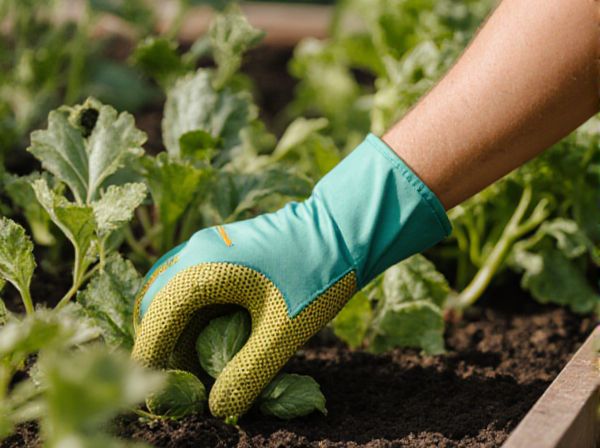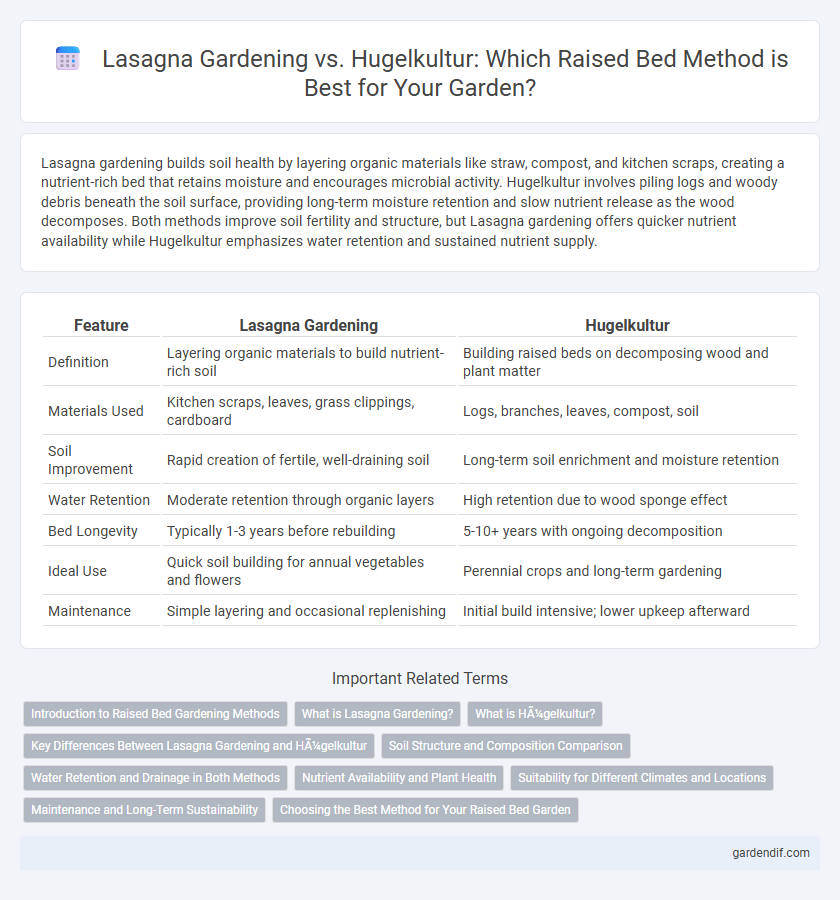
Lasagna gardening vs Hügelkultur Illustration
Lasagna gardening builds soil health by layering organic materials like straw, compost, and kitchen scraps, creating a nutrient-rich bed that retains moisture and encourages microbial activity. Hugelkultur involves piling logs and woody debris beneath the soil surface, providing long-term moisture retention and slow nutrient release as the wood decomposes. Both methods improve soil fertility and structure, but Lasagna gardening offers quicker nutrient availability while Hugelkultur emphasizes water retention and sustained nutrient supply.
Table of Comparison
| Feature | Lasagna Gardening | Hugelkultur |
|---|---|---|
| Definition | Layering organic materials to build nutrient-rich soil | Building raised beds on decomposing wood and plant matter |
| Materials Used | Kitchen scraps, leaves, grass clippings, cardboard | Logs, branches, leaves, compost, soil |
| Soil Improvement | Rapid creation of fertile, well-draining soil | Long-term soil enrichment and moisture retention |
| Water Retention | Moderate retention through organic layers | High retention due to wood sponge effect |
| Bed Longevity | Typically 1-3 years before rebuilding | 5-10+ years with ongoing decomposition |
| Ideal Use | Quick soil building for annual vegetables and flowers | Perennial crops and long-term gardening |
| Maintenance | Simple layering and occasional replenishing | Initial build intensive; lower upkeep afterward |
Introduction to Raised Bed Gardening Methods
Raised bed gardening methods such as lasagna gardening and hugelkultur offer innovative solutions for improving soil fertility and moisture retention. Lasagna gardening involves layering organic materials like compost, straw, and leaves to create nutrient-rich soil without tilling. Hugelkultur incorporates decomposing wood and biomass within raised beds to enhance aeration, water conservation, and long-term soil health.
What is Lasagna Gardening?
Lasagna gardening is an organic, no-dig technique that builds garden beds by layering decomposing materials like leaves, grass clippings, kitchen scraps, and compost directly on top of the soil. This method improves soil fertility, moisture retention, and aeration as the layers break down, mimicking natural forest floor processes. Unlike Hugelkultur, which uses large woody logs and branches at its core, lasagna gardening relies primarily on thin, easily decomposable organic matter to create nutrient-rich, raised beds.
What is Hügelkultur?
Hugelkultur is a sustainable gardening method that uses decomposing wood and organic materials buried under soil to create nutrient-rich, moisture-retentive raised beds. This technique enhances soil fertility, improves water retention, and promotes healthy plant growth by mimicking natural forest soil processes. Unlike lasagna gardening, which layers organic matter above ground, Hugelkultur builds raised beds with buried woody debris to foster long-term soil ecology.
Key Differences Between Lasagna Gardening and Hügelkultur
Lasagna gardening builds soil by layering organic materials like leaves, grass clippings, and compost directly in a raised bed, promoting rapid decomposition and nutrient-rich soil. Hugelkultur involves creating mounds or raised beds using large woody debris such as logs and branches, which decompose slowly, improving water retention and aeration over time. The key difference lies in material composition and decomposition speed: lasagna gardening emphasizes quick nutrient cycling, while hugelkultur prioritizes long-term soil fertility and moisture management.
Soil Structure and Composition Comparison
Lasagna gardening improves soil structure by layering organic materials such as compost, leaves, and grass clippings, creating rich, loose, and nutrient-dense soil that retains moisture well. Hugelkultur, on the other hand, incorporates large woody debris like logs and branches beneath the soil layers, promoting long-term aeration and slow nutrient release as the wood decomposes. While lasagna gardening emphasizes immediate nutrient availability, hugelkultur enhances soil composition over time through improved drainage and sustained organic matter integration.
Water Retention and Drainage in Both Methods
Lasagna gardening uses layered organic materials that enhance water retention by slowly decomposing and maintaining moisture, promoting steady drainage without waterlogging. Hugelkultur involves piling wood and compost, creating a sponge-like core that absorbs excess water while allowing deep soil aeration and preventing drainage issues. Both methods optimize water management, but Hugelkultur excels in prolonged moisture release due to decomposing wood's sponge effect.
Nutrient Availability and Plant Health
Lasagna gardening enhances nutrient availability by layering organic materials that decompose into rich soil, providing consistent nutrient release and improved moisture retention for healthier plants. Hugelkultur incorporates decomposing wood and organic matter, which initially immobilizes nutrients but gradually releases them over time, fostering long-term soil fertility and plant resilience. Both methods promote robust plant health, though lasagna gardens offer quicker nutrient access while hugelkultur supports sustained soil enrichment.
Suitability for Different Climates and Locations
Lasagna gardening thrives in temperate climates with ample organic waste availability, making it ideal for urban and suburban gardens where soil improvement is needed without major earthworks. Hugelkultur suits cooler, wetter climates with abundant wood debris, offering excellent moisture retention and insulation for plants in forested or rural areas. Both methods enhance soil fertility, but lasagna gardening is better for flat, confined spaces, while hugelkultur works well on slopes or larger plots with natural wood resources.
Maintenance and Long-Term Sustainability
Lasagna gardening requires regular layering of organic materials, fostering nutrient-rich soil but demanding consistent maintenance to prevent decomposition imbalances. Hugelkultur offers enhanced moisture retention and nutrient cycling by using decomposing wood and plant matter, reducing watering frequency and long-term input needs. Both methods improve soil health, but Hugelkultur provides greater sustainability with less ongoing effort due to its self-sustaining ecosystem.
Choosing the Best Method for Your Raised Bed Garden
Lasagna gardening builds rich, layered soil using organic materials such as kitchen scraps, leaves, and compost, promoting rapid decomposition and nutrient availability. Hugelkultur incorporates decomposing wood and branches buried beneath soil, enhancing moisture retention and long-term fertility for raised beds with poor drainage. Selecting between these methods depends on your garden's specific soil needs, moisture levels, and desired maintenance intensity.
Lasagna gardening vs Hügelkultur Infographic

 gardendif.com
gardendif.com